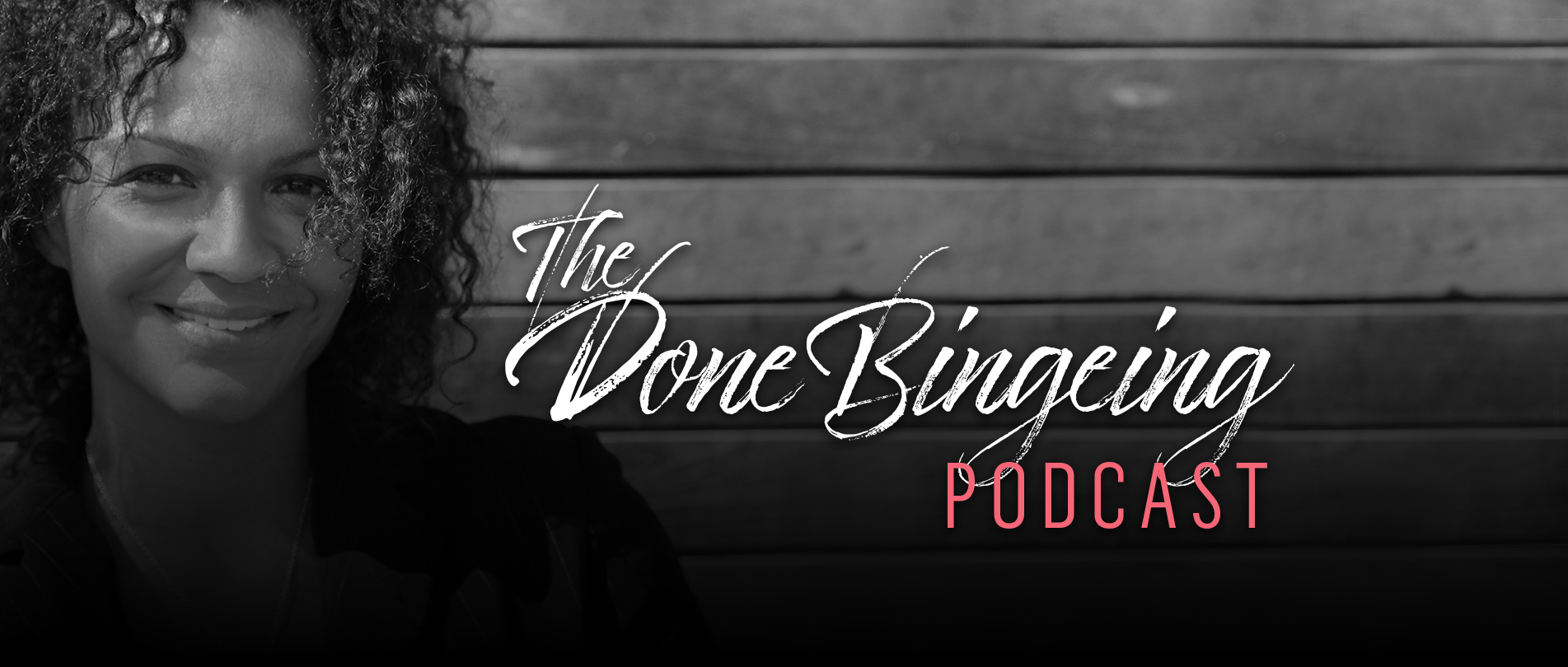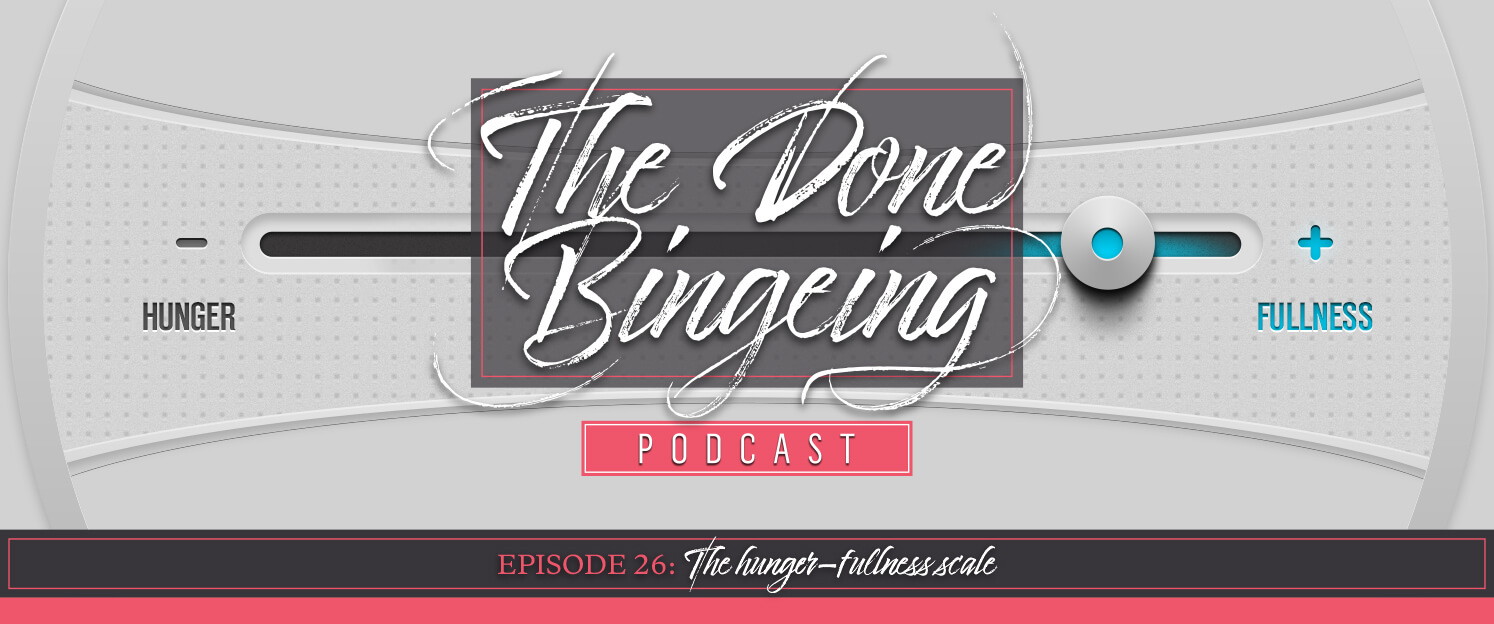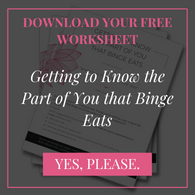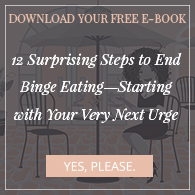
EP #26: The hunger–fullness scale

If you’re open to looking for signs of physical hunger—and to experiencing it once it arrives—this episode will take you a little deeper. In addition to understanding how your body signals physical hunger, it’s helpful to understand how the intensity of your hunger changes over time. Using a number scale to assess hunger and fullness can help you to get in touch, and stay in touch, with physical sensations of hunger and fullness. This scale helps you determine how hungry or full you are, and to put numbers to your experience. Listen in to find out more!
Get full show notes and more information here: https://www.holdingthespace.co/26
Episode: Play in new window
Subscribe: iTunes | Google Play | Stitcher | RSS
- How your hunger intensity changes over time.
- The difference between different levels of hunger and fullness for you.
- Where on the hunger scale it makes sense for you to start eating.
- Where on the fullness scale it makes sense for you to stop eating.
What do IKEA furniture and a convertible with the top down have to do with how much you eat? Keep listening!
Welcome to The Done Bingeing Podcast. This is the place to hear about how you can pair the emerging brain science about why you binge with powerful life coaching to help you stop. If you want to explore a non-clinical approach to end binge eating, you’re in the right place. It’s time to free yourself. You have more power than you know. And now, your host, Life and Weight-Loss Coach Martha Ayim.
Welcome to Episode 26 of The Done Bingeing Podcast.
As we’ve been discussing in the last few episodes, we often eat because we’re not in tune with our hunger and fullness. And sometimes we mistake emotional hunger for physical hunger.
If you’ve been open to looking for signs of physical hunger—whether in your tummy or other areas of your body—and if you’re open to experiencing it once it arrives, let’s dig a little deeper.
In addition to understanding how your body signals physical hunger, it’s helpful to understand how the intensity of your hunger changes over time.
To explore this, of course, you may need to toss external cues about when you’re “supposed” to eat, at least until you’re reacquainted with your internal cues. Why? Because you may not be hungry at the crack of dawn or when the lunch-’n’-learn comes with a hosted assortment of sandwiches and cookies.
Following true physiological hunger will require you to forgo preconceptions of what a meal or a mealtime “should” be. When you eat when you get a physical signal that it’s time to eat, instead of when you get an emotional signal that you need to eat or a social signal that ought to be eat, you will reinforce a confidence and calm that you have the ability to take care of your nutritional needs. And you’ll strengthen a new neural connection away from bingeing or overeating in any form.
Remember to get excited about any progress you make in this direction. Emotional intensity is like glue in the brain. It helps to cement neural connections together. So, try to stay neutral and compassionate about the times you eat in a way you wish you hadn’t, and try to truly savor pride for the times you eat in alignment with your goals.
Many people, including my teacher, Brooke Castillo, use a scale to assess hunger and fullness to get in touch, and stay in touch, with physical sensations of physiological hunger and fullness. This scale helps you determine how hungry or full you are, and to put numbers to your experience.
Imagine a horizontal line that extends from -10 on the left to +10 on the right. -10 is a measure for hunger that’s so extreme that you’re too weak to move. +10 is a measure for fullness that’s so extreme that you’re too stuffed to move. 0 is neutral, with no sensation of hunger or fullness.
What does your body feel like at a 0?
-1 is the tiniest whisper of hunger. What does this whisper feel like for you in your body?
What does -2 feel like for you? What about -3 or -4?
+2 is just satisfied—not full. What does this feel like for you? Light and energetic? Or something else?
What about +3 or +4?
What number do you think you’re at on the scale right now?
Where were you on the scale before your last meal? And where were you after? Did you even know?
Where were you on the scale after your last overeating experience, and how did that feel in your body?
Does your fullness level go up or down after a meal? For some people, they stop eating at a certain number on the fullness scale, but then feel increasingly full over the course of the next hour or so. Does this happen for you, too?
Is there a point on the hunger scale that leaves you most vulnerable to overeat? Some people find that letting themselves get below a -2 on the hunger scale makes it harder to hear the gentle satisfaction of a +2—even though getting a little further below -2 isn’t an emergency, just a stronger signal to get some food.
Staying between -2 and +2 allows you to flow between a slight hunger and a light fullness. But that may not be quite right for you.
Some of my clients find eating from -2 to +2 distracting and find that it leaves them thinking about food more often than they’d like—mind you, these clients also tend to be the less afraid of hunger and they’re cool to let it drop to a -3, -4, or even -5, without freaking and tearing through a full-size Hawaiian pizza in response.
For other clients, hunger still feels dangerous for now and what works best for them is to respond soon after they notice its first signs.
There was a time when feeling less than stuffed (and I mean about a 9 on the fullness scale) left me feeling shaky. For years, I wouldn’t even look at hunger out of the corner of my eye. For one thing, I’d been telling myself that if I dared to get hungry, I’d eat everything in sight. But the truth was that I was eating everything in sight anyway. What I was really afraid of was hunger, itself.
One day, I asked myself to risk feeling an 8 on the fullness scale. Gingerly, I eased into 8. Then, gradually, over several weeks, I tippie-toed into 7, slipped into 6, and peered into 5. Down the fullness scale I went, one tentative notch at a time, until I arrived at the edge of hunger, a little nervous, but, on the whole, totally okay.
I reminded myself that I had vowed to eat when I was hungry. I was done with years of cavernous hunger from the ghosts of diets past. I had believed that I lacked any control around food and so I needed a set of rules imposed from the outside to confine me. But that confinement just made me want to bust out of there with burritos and butterscotch ice cream.
I reminded myself that I could afford to buy food for my next meal, that I had the privilege of knowing that hunger really wasn’t a crisis for me—even though it had felt like one in the past.
Try to discern the difference between different levels of hunger and fullness for you.
Then try to get a sense of where on the hunger scale it makes sense for you to start eating. Would that be when you hear a lilt of a whisper in your ear or the screech of nails on a chalkboard?
Try to gauge where on the fullness scale it makes sense for you to stop eating. Would that come with the spacious feeling of riding in a coupe with the roof down? Or would that be more akin to squeezing into a 4 X 4 stacked inside and out with IKEA’s infamous furniture boxes filled with hours of self-assembly delight?
Whatever your pitch, whatever your ride, choose what feels right for you. These can become guides and begin to form part of an intuitive, internal matrix guiding when and how much you eat.
You get to decide what is a comfortable range of hunger and fullness.
When you really pay attention, you may notice a payoff bigger than you expected.
You may soon notice a waning interest in eating when you’re not hungry.
Why?
Because it just feels so darn good to take care of your needs with greater precision. And because your body feels more comfortable more of the time.
Attention, in so many ways, is the way out.
And as you know, the quality of that attention matters.
A scolding watchfulness from the outside with chain you.
A gentle watchfulness from the inside will free you.
A scowl in the mirror will throw you.
But a nod to your reflection will hold you.
Give yourself a nod in every way you can. You need it. You deserve it.
Nod, then turn and move away, knowing that you’ve got your own back.
Oh, and, just so you know, although you can’t see me, I’m nodding at you right now.
That’s it for Episode 26. Thank you for listening. The Done Bingeing Podcast is helping people to reduce their bingeing and overeating, and to find out who they’re truly meant to be when they live their lives fully. Ratings and reviews will help more people find this podcast and get the help they need. So, if you’re getting something out of this podcast, I would be honored if you’d be willing to take the time to leave me a rating and review. Just go to www.holdingthespace.co/itunes-review for easy-peasy instructions on how to get it done. Thank you so much!
Thanks for listening to The Done Bingeing Podcast. Martha is a certified life and weight loss coach who’s available to help you stop bingeing. Book a free session with her at www.holdingthespace.co/book. And stay tuned for next week’s episode on freeing yourself from binge eating and creating the life you want.
- Never miss an episode by subscribing via iTunes, Stitcher, Google Play, or RSS.
- Leave a rating and review in iTunes.
- Have a question or topic you’d like to see covered on the podcast? Send it on over to support@holdingthespace.co.
- If you found this episode valuable, it would mean so much to me if you would please share it with your friends.
In the comments below, please tell me:
- How does your body feel at 0?
- -1 is the tiniest whisper of hunger. What does this whisper feel like in your body?
- What does -2 feel like for you? What about -3 or -4?
- +2 is just satisfied—not full. What does this feel like for you? Light and energetic? Or something else?
- What about +3 or +4?
- What number do you think you’re at on the scale right now?
- Where were you on the scale before your last meal? And where were you after? Do you know?
- Where were you on the scale after your last overeating experience?
- Does your fullness level go up or down after a meal?
- Is there a point on the hunger scale that leaves you most vulnerable to overeat?
Thank you so much for sharing your thoughts with me.
Sending much love to you!






















0 Comments